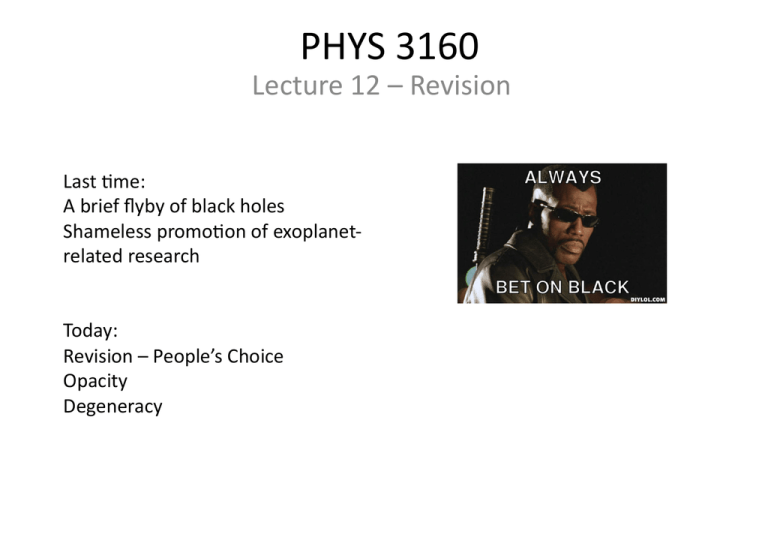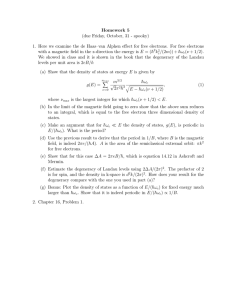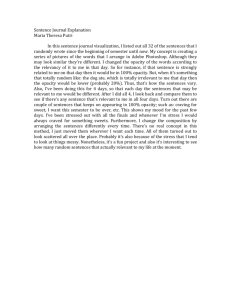Lecture 12
advertisement

PHYS 3160 Lecture 12 – Revision Last 9me: A brief flyby of black holes Shameless promo9on of exoplanet-­‐ related research Today: Revision – People’s Choice Opacity Degeneracy The Exam OMB 144, start 2pm Friday 7 Nov 3160: 2 hours. Everyone else: 3 hours (1-­‐2 extra ques9ons) Past exams are useful guides on format, type of ques9ons asked. Use psychology: Do I enjoy filling boards with deriva9ons? Then it is unlikely I will waste our valuable assessment 9me making you brain-­‐dump maths that can be Googled. Helpful hint: What topics did we spend a lot of 9me on? The things that appear to be most important probably are. A stroll down amnesia lane Review guide stolen from 2012 incarna9on of this course. A stroll down amnesia lane Review guide stolen from 2012 incarna9on of this course. Energy genera9on processes: what goes in and what goes out. In what types of stars are PP, CN, triple alpha important? A stroll down amnesia lane Review guide stolen from 2012 incarna9on of this course. Wall of text intermission A stroll down amnesia lane Review guide stolen from 2012 incarna9on of this course. A stroll down amnesia lane Review guide stolen from 2012 incarna9on of this course. A stroll down amnesia lane Review guide stolen from 2012 incarna9on of this course. People’s Choice: Degeneracy So far we have assumed the gas in a star to be ideal, obeying the ideal-­‐gas equa9on of state: Pgas = RρT/µ But what happens when we pack the gas par9cles closer together? Electrons must obey Pauli’s exclusion principle: No more than two electrons (of opposite spin) can occupy the same quantum state. Pauli Exclusion Principle In high school chemistry, this meant a given energy level in an atom could only have two electrons. For a fully ionised plasma as in stars, we can think of the quantum state not as a specific ‘orbital’ like we did in chemistry class. Instead, think of the quantum state as a set of 6 coordinates: x, y, z, px, py, pz represen9ng the electron’s posi9on and momentum. Because of the Heisenberg Uncertainty Principle: Think of the quantum state as a volume of phase space equal to h3. Electron Degeneracy When you cram electrons together 9ghtly enough, eventually they are forced to occupy higher values of momentum space to be in that posi8on space. Result: Gas at a given temperature and density will have a higher pressure than expected by classical (ideal) gas laws. This is called a degenerate gas. Dashed line: classical (Maxwellian) distribu9on. Solid lines: Effect of degeneracy – electrons are shiged to higher momenta. ρC > ρB > ρA In what types of stars is degeneracy important? • White dwarfs • Brown dwarfs (core not hot enough. Low T, high density) • Neutron stars (neutron degeneracy) No nuclear fusion degeneracy pressure balances gravity People’s Choice: Opacity Sources of opacity Opacity κ – it’s back! Determined by the processes which scajer and absorb photons. Four types of processes: • Bound-­‐bound absorp9on • Bound-­‐free absorp9on • Free-­‐free absorp9on • Scajering True absorp9on – photon disappears Only changes direc9on of the photon Sources of opacity Bound-­‐Bound Absorp9on A photon of energy hν hits a bound electron, causing it to jump from energy E1 to E2. This creates the spectral lines we see in stellar atmospheres. But in the centres of stars, the atoms are highly ionised! So there are very few bound electrons, and this process is NOT important for the overall opacity. Also, most photons have enough energy to knock any bound electrons free. Sources of opacity Bound-­‐Free Absorp9on A photon of energy hν hits a bound electron, causing it to jump from energy E1 to E3, which kicks it out completely. Again, there are very few bound electrons, so this process is not very important for the overall opacity. But because the photons are so energe9c, this is more likely than bound-­‐bound. Sources of opacity Free-­‐Free Absorp9on A free electron is minding its own business when suddenly a wild PHOTON appears! The electron absorbs the photon and moves from energy E3 to E4. This is quite common and is considered a con9nuous absorp9on process since a photon of any* energy can do it. *Condi9ons apply. If we are in a degenerate gas, Pauli Exclusion Principle becomes important and the photon must have enough energy to put the electron into an allowed state. Sources of opacity Scajering Exactly what it sounds like, in the classical Approxima9on where hν << mc2 Then we can think of this as a collision where the photon and electron (or proton or nucleus) bounce off of each other. The scajering par9cle can then be considered sta9onary, and the photon bounces. This is considered “opacity” since it slows the rate at which energy leaves the star. At low and high T, opacity is low. Why? Low T: Most atoms not ionised few free electrons for scajering or free-­‐free absorp9on. The available photons also do not have enough energy to liberate electrons. High T: Most atoms are fully ionised, photons have high energy Free-­‐free absorp9on is harder than for low-­‐energy photons. Electron scajering is dominant (independent of T, hence flat in region c) At high T, opacity is constant (region c above). κ = κ0 At low T, opacity rises with temperature (region a above). Dashed line approximates power law: κ = κ0ρ1/2T4 Most atoms NOT ionised few electrons available for scajering or free-­‐free absorp9on. The photons do not have enough energy to ionise via bound-­‐free absorp9on. Opacity is highest at intermediate T, where bound-­‐free and free-­‐free absorp9ons are important. (region b above) Dashed line approximates power law: κ = κ0ρT-3.5 Closing thoughts


